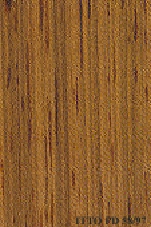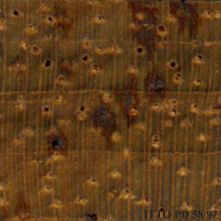
TCHITOLA (Oxystigma mannii)
Trade Name
Tchitola
Scientific Name
Oxystigma mannii Harms
Family
LEGUMINOSAE
Common Names
Lolagbola (Nigeria); Tschibudimbu (Zaire); Akwakwa (Zaire); M'babou (Gabon); Emola (Gabon); Tchitola (Congo); Kitola (Congo); Tola chinfuta (Angola); Tchitola
Scientific Name Synonyms
Copaifera mannii Baill.
Description Of The Tree
Botanical Description
The tree reaches a height of 43 m. The bole is cylindrical with a swollen base. The trunk diameter attains up to 200 cm.
Natural Habitat
Oxystigma mannii is found mainly in low-lying swampy areas and along rivers.
Non Timber Uses
Contains some resins or extracts which could pose problems when machining or finishing.
Wood Identification
Anatomic Description Of Wood
Wood diffuse porous. Occasionally vessels exclusively solitary (over 90%). Tangential diameter of vessel lumina 200 micras or more (large). Vestured pits. Vessels per mm2 less than 6 (rare). Simple perforation plates. Vessel-ray pits similar to intervessel pits Paratracheal axial parenchyma scanty and/or vasicentric. Axial parenchyma aliform. Prismatic crystals in chambered axial parenchyma cells and/or in fibers. 3 to 4 cells per parenchyma strand. Rays non-storied. Rays 1 to 4 seriate. Body ray cells procumbent with mostly 2 to 4 rows of upright and/or square marginal cells (Kribs-II). Non-septate fibers. Fibers with simple to minutely bordered pits.
-
 Wood Macro Photo Tangential Plane
Wood Macro Photo Tangential Plane
-
 Wood Micro Photo Of Transversal Section
Wood Micro Photo Of Transversal Section
Availability
Cites Status
Unrestricted
General Wood Description
Color
The sapwood is pink white, it has a thickness of up to 25 cm. The heartwood is reddish brown with dark rings, it is clearly demarcated. The silver figure is fine.
COLOR INDEX (1=Black, 7=Light yellow,white)
4
Grain
Straight or slightly interlocked, sometimes with an influence on further processing operations.
Texture
The texture is mostly medium to coarse.
Luster
The surface of the wood is naturally low in luster.
Natural Durability
Moderately durable to decay. Without preservative treatment, this species can be used only under risk of occasional re-humidification. It is not suited for uses with risks of permanent or long-lasting humidification. Moderately resistant to termites attack
Natural durability index (1= Very high durability, 7=Vey low durability)
3
Internal Growth Stresses
No residual stresses are reported in this species.
Resistance To Impregnation
Difficult to treat with only a low penetration of the preservative products.
Wood Physical Properties
Basic Density or Specific Gravity (O.D. weight/vol. green) (g/cm³)
0.47
Air-dry Density (Weight and volume at 12%MC) (g/cm³)
0.51
Drying Defects
Ease of Drying: Drying is fairly easy; some difficulties could occur when drying too fast. Drying Defects: No particular risks of drying defects, subject to normal drying conditions. Kiln Schedules: The kiln schedule has been tested.
Recommended Dry Kiln Schedule
FR-4
Wood Chemical Properties
Wood Mechanical Properties
Bending Strength (MOR),12%MC (kgf/cm²)
711
Compression parallel to fiber 12%MC (kgf/cm²)
448
Compression perpendicular to fiber 12%MC (kgf/cm²)
53
Janka hardness (side) 12%MC (kgf)
318
Janka hardness (end grain) 12%MC (kgf)
421
Workability
Sawing
It is easy to saw.
Rotary Veneer Cutting
Suitable for peeling if treated.
Sliced Veneer
Suitable for peeling if treated.
Blunting Effect
Slight blunting effect; ordinary tools can be used for sawing and machining.
Machining
Machining of this species is reportedly easy.
Planing
Easy; no particular problems.
Moulding
Easy; no particular problems.
Boring
Easy; no particular problems.
Mortising
Easy; no particular problems.
Nailing
No particular problem.
Gluing
Difficult to glue because of the extracts content.
Sanding
Easy to perform; it gives good results.
Polishing
Needs pre-coating.
Response To Hand Tools
No particular problems.
REFERENCED USES
End Uses Summary
HOUSING GENERAL, beams, joists, boards, frames, steps, panelling, fittings, shutter boards, FURNITURE AND CABINETS, common furniture, PLYWOOD AND VENEER, faces, cores, PACKING, heavy packing, pallets, OTHER AND MUSICAL INSTRUMENTS, door core, shingle, coffin, cementboard
General Housing
- 10 - Silica in Timbers
Beams
- 11 - Prospect: The wood database
Joists
- 12 - Tropical timbers of the world. Part I-Tropical American Species
Boards
- 13 - Dry kiln schedules for commercial woods. Temperate and tropical. Section III. Latin American (Mexico, Central, and South America) Woods–Conventional Temperatures
Frames
- 16 - Woods of the World
Steps
- 17 - Tree Conservation Database
Paneling
- 18 - W3TROPICOS Missouri Botanical Garden
Fittings
- 19 - Silica in Timbers
Shutter Boards
- 20 - Prospect: The wood database
Furniture Cabinets
- 21 - Tropical timbers of the world. Part III-Southeast Asian and Oceanian Species.
Furniture, Common
- 23 - Handbook of Hardwoods
Panels, Veneers
- 25 - Directory of Timber Trade Malaysia
Faces
- 26 - Annual Review and Assessment of the World Timber Situation 1998-ITTO
Cores
- 27 - Embassy of Brazil in Japan
Packing
- 45 - Recopilación y Análisis de Estudios Tecnológicos de Maderas Peruanas
Heavy Packing
- 47 - Arvores Brasileiras
Pallets
- 48 - The strength properties of timbers
Door Cores
- 76 - Descripción General y Anatómica de 105 Maderas del Grupo Andino.
Shingles
- 77 - Amazonian Timbers, Characteristics and Utilization Volume I; Tapajós National Forest
Coffin
- 78 - Amazonian Timbers for the International Market
Cementboard
- 81 - Madeiras da Amazônia: descrição do lenho de 40 espécies ocorrentes na Floresta Nacional do Tapajós
Please Provide Information To View Producer Information